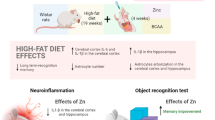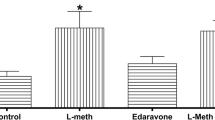Abstract
Methionine is an essential amino acid found in rich quantities in average American diet such as meats, fish and eggs. Excessive consumption of such food often exceeds the normal requirement of the methionine in our body; which found to be related to the development of neurodegenerative disorders. However, the mechanistic pathways of methionine’s influence on the brain are unclear. The present study is focus on the effects of high methionine, low folate and low vitamin B6/B12 (HM-LF-LV) diet on the dysfunction of neuronal and vascular specific markers in the brain. C57BL6/J male mice (8–10 week old) were fed with HM-LF-LV diet for a 6 week period. Cognitive function of mice was determine by measuring short-term memory using a Novel Object Recognition test (NORT). Neuronal dysfunction were evaluate by measuring the levels of Neuronal nuclear antigen (NeuN), Neuron-specific-enolase (NSE) and Fluoro-jade C(FJC) fluorescence; while cerebrovascular disruption were evaluate by assessing levels of endothelial junction proteins Vascular Endothelial-Cadherin (VE-Cadherin) and Claudin-5 in harvested brain tissue. Cerebrovascular permeability was assess by evaluating microvascular leakage of fluorescently labeled albumin in vivo. Endothelial and Neuronal Nitric Oxide Synthase (eNOS, nNOS) regulation and vascular inflammation (ICAM: intercellular adhesion molecules) were also evaluate in brain tissue. All assessments were conduct at weekly intervals throughout the study duration. NORT showed a significant temporal decrease in short-term memory of mice fed on HM-LF-LV diet for 6 weeks compared to the wild-type control group. Our experimental data showed that neuronal dysfunction (decreased NeuN levels and increased FJC positive neurons in brain) was more prominent in HM-LF-LV diet fed mice compared to normal diet fed control mice. In experimental mice, cerebrovascular disruption was found to be elevated as evident from increased pial venular permeability (microvascular leakage) and decreased in VE-Cadherin expression compared to control. Slight decrease in nNOS and increase in eNOS in experimental mice suggest a trend towards the decrease in potential for neuronal development due to the long-term HM-LF-LV diet fed. Collectively, our results suggest that a diet containing high methionine, low folate and low vitamin B6/B12 results in increased neuronal degeneration and vascular dysfunction, leading to short-term memory loss. Interestingly, significant neuronal damage precedes vascular dysfunction.





Similar content being viewed by others
References
Basati G, Razavi AE, Abdi S, Sarrafzedegan N (2014) Association of plasma leptin, homocysteine and nitric oxide levels with the presence and unstability of coronary artery disease. Biomark Med 8:405–412
Chaturvedi P, Kamat PK, Kalani A, Familtseva A, Tyagi SC (2016) High methionine diet poses cardiac threat: a molecular insight. J Cell Physiol 231:1554–1561
Cheng J, Kaplowitz N (2004) Hyperhomocysteinemia, endoplasmic reticulum stress, and alcoholic injury. World J Gastroenterol 10:1699–1708
Chow K, Cheung F, Lao TT, O K (1999) Effect of homocysteine on the production of nitric oxide in endothelial cells. Clin Exp Pharmacol Physiol 26:817–818
Clarke R, Smith AD, Jobst KA, Refsum H, Sutton L, Ueland PM (1998) Folate, vitaminB12, and serum total homocysteine levels in confirmed Alzheimer disease. Arch Neurol 55:1449–1455
FAO/WHO (1973) "Energy and Protein Requirements." Report of a Joint FAO/WHO Ad Hoc Expert Committee Technical Report Series No. 552; FAO Nutrition Meetings Report Series 52. http://apps.who.int/iris/bitstream/10665/41042/1/WHO_TRS_522_eng.pdf
Förstermann U, Sessa WC (2012) Nitric oxide synthases: regulation and function. Eur Heart J 33:829–837
Ganguly P, Alam SF (2015) Role of homocysteine in the development of cardiovascular disease. Nutr J 14:6
Gomez J, Caro P, Sanchez I, Naudi A, Jove M, Portero-Otin M, Lopez-Torres M, Pamplona R, Barja G (2009) Effect of methionine dietary supplementation on mitochondrial oxygen radical generation and oxidative DNAdamage in ratliver and heart. J Bioenerg Biomembr 41:309–321
Hainsworth AH, Yeo NE, Weekman EM, Wilcock DM (2016) Homocysteine, hyperhomocysteinemia and vascular contributions to cognitive impairment and dementia (VCID). Biochim Biophys Acta 1862:1008–1017
Hankey GJ, Eikelboom JW (2001) Homocysteine and stroke. Curr Opin Neurol 14:95–102
Harper AE, Benevenga NJ, Wohlhueter RM (1970) Effects of ingestion of disproportionate amounts of amino acids. Physiol Rev 50:428–558
Irwin MI, Hegsted DM (1971) A conspectus of research on amino acid requirements of man. J Nutr 101:539–566
Jacobsen DW (2000) Hyperhomocysteinemia and oxidative stress: time for a reality check? Arterioscler Thromb Vasc Biol 20:1182–1184
Kalani A, Kamat PK, Familtseva A, Chaturvedi P, Muradashvili N, Narayanan N, Tyagi SC, Tyagi N (2014) Role of microRNA29b in blood-brain barrier dysfunction during hyperhomocysteinemia: an epigenetic mechanism. J Cereb Blood Flow Metab 34:1212–1222
Kalani A, Kamat PK, Tyagi N (2015) Diabetic stroke severity: epigenetic remodeling and neuronal, glial, and vascular dysfunction. Diabetes 64:4260–4271
Kalani A, Pushpakumar SB, Vacek JC, Tyagi SC, Tyagi N (2016) Inhibition of MMP-9 attenuates hypertensive cerebrovascular dysfunction in Dahl salt-sensitive rats. Mol Cell Biochem 413:25–35
Kamat PK, Kalani A, Givvimani S, Sathnur PB, Tyagi SC, Tyagi N (2013) Hydrogensulfideattenuatesneurodegeneration and neurovasculardysfunctioninduced by intracerebral-administered homocysteine in mice. Neuroscience 252:302–319
Kamath AF, Chauhan AK, Kisucka J, Dole VS, Loscalzo J, Handy DE, Wagner DD (2006) Elevated levels of homocysteine compromise blood-brain barrier integrity in mice. Blood 107:591–593
Koladiya RU, Jaggi AS, Singh N, Sharma BK (2008) Ameliorative role of atorvastatin and Pitavastatin in L-methionine induced vascular dementia in rats. BMC Pharmacol 8:14. https://doi.org/10.1186/1471-2210-8-14
Leger M, Quiedeville A, Bouet V, Haelewyn B, Boulouard M, Schumann-Bard P, Freret T (2013) Object recognition test in mice. Nat Protoc 8:2531–2537
Lominadze D, Roberts AM, Tyagi N, Moshal KS, Tyagi SC (2006) Homocysteine causes cerebrovascular leakage in mice. Am J Physiol Heart Circ Physiol 290:H1206–H1213
Lu K, Xu X, Cui S, Wang F, Zhang B, Zhao Y (2015) Serum neuron specific enolase level as a predictor of prognosis in acute ischemic stroke patients after intravenous thrombolysis. J Neurol Sci 359:202–206
Lueptow LM (2017) Novel object recognition test for the investigation of learning and memory in mice. J Vis Exp 126. https://doi.org/10.3791/55718
Mattson MP, Shea TB (2003) Folate and homocysteine metabolism in neural plasticity and neurodegenerative disorders. Trends Neurosci 26:137–146
Miller JW (1999) Homocysteine and Alzheimer's disease. Nutr Rev 57:126–129
Miller AL (2003) The methionine-homocysteine cycle and its effects on cognitive diseases. Altern Med Rev 8:7–19
Millward J (1990) Amino acid requirements in adult man. Am J Clin Nutr 51:492–496
Mori N, Hirayama K (2000) Long-term consumption of a methionine-supplemented diet increases iron and lipid peroxide levels in rat liver. J Nutr 130:2349–2355
Muradashvili N, Tyagi R, Metreveli N, Tyagi SC, Lominadze D (2014) Ablation of MMP9 gene ameliorates paracellular permeability and fibrinogen-amyloid beta complex formation during hyperhomocysteinemia. J Cereb Blood Flow Metab 34:1472–1482
Obeid R, Herrmann W (2006) Mechanisms of homocysteine neurotoxicity in neurodegenerative diseases with special reference to dementia. FEBS Lett 580:2994–3005
O'Dell TJ, Hawkins RD, Kandel ER, Arancio O (1991) Tests of the roles of two diffusible substances in long-term potentiation: evidence for nitric oxide as a possible early retrograde messenger. Proc Natl Acad Sci U S A 88:11285–11289
Oldendorf WH, Szabo J (1976) Amino acid assignment to one of three blood-brain barrier amino acid carriers. Am J Phys 230:94–98
Sabour H, Nazari M, Latifi S, Soltani Z, Shakeri H, Larijani B, Ghodsi SM, Razavi SHE (2016) The relationship between dietary intakes of amino acids and bone mineral density among individuals with spinal cord injury. Oman Med J 31:22–28
Schmued LC, Stowers CC, Scallet AC, Xu L (2005) Fluoro-jade C results in ultra high resolution and contrast labeling of degenerating neurons. Brain Res 1035:24–31
Shen Y, Gao HM (2015) Serum somatostatin and neuron-specific enolase might be biochemical markers of vascular dementia in the early stage. Int J Clin Exp Med 8:19471–19475
Siri PW, Verhoef P, Kok FJ (1998) Vitamins B6, B12, and folate: association with plasma total homocysteine and risk of coronary atherosclerosis. J Am Coll Nutr 17:435–441
Smith AD (2008) The worldwide challenge of the dementias: a role for B vitamins and homocysteine? Food Nutr Bull 29:S143–S172
Troen AM, French EE, Roberts JF, Selhub J, Ordovas JM, Parnell LD, Lai CQ (2007) Lifespan modification by glucose and methionine in Drosophila melanogaster fed a chemically defined diet. Age (Dordr) 29:29–39
Tyagi N, Sedoris KC, Steed M, Ovechkin AV, Moshal KS, Tyagi SC (2005) Mechanisms of homocysteine-induced oxidative stress. Am J Physiol Heart Circ Physiol 289:H2649–H2656
Upchurch GR Jr, Welch GN, Fabian AJ, Pigazzi A, Keaney JF Jr, Loscalzo J (1997) Stimulation of endothelial nitric oxide production by homocyst(e)ine. Atherosclerosis 132:177–185
Wang G, Woo CW, Sung FL, Siow YL O K(2002) Increased monocyte adhesion to aortic endothelium in rats with hyperhomocysteinemia: role of chemokine and adhesion molecules. Arterioscler Thromb Vasc Biol 22:1777–1783
Yang AN, Zhang HP, Sun Y, Yang XL, Wang N, Zhu G, Zhang H, Xu H, Ma SC, Zhang Y, Li GZ, Jia YX, Cao J, Jiang YD (2015) High-methionine diet accelerate atherosclerosis by HHcy-mediatedFABP4genedemethylationpathwayviaDNMT1 in ApoE(−/−) mice. FEBS Lett 589:3998–4009
Young SN, Shalchi M (2005) The effect of methionine and S-adenosylmethionine on S-adenosylmethionine levels in the rat brain. J Psychiatry Neurosci 30:44–48
Zhang X, Li H, Jin H, Ebin Z, Brodsky S, Goligorsky MS (2000) Effects of homocysteine on endothelial nitric oxide production. Am J Physiol Renal Physiol 279:F671–F678
Zhang JW, Yan R, Tang YS, Guo YZ, Chang Y, Jing L, Wang YL, Zhang JZ (2017) Hyperhomocysteinemia-induced autophagy and apoptosis with downregulation of hairy enhancer of split 1/5 in cortical neurons in mice. Int J Immunopathol Pharmacol 30:371–382
Zhuo JM, Portugal GS, Kruger WD, Wang H, Gould TJ, Pratico D (2010) Diet-induced hyperhomocysteinemia increases amyloid-beta formation and deposition in a mouse model of Alzheimer's disease. Curr Alzheimer Res 7:140–149
Acknowledgments
NIH (National Institute of Health) Grant HL-107640 and AR-067667 to NT and NS-084823 to DL supported this study.
Author information
Authors and Affiliations
Corresponding author
Rights and permissions
About this article
Cite this article
Nuru, M., Muradashvili, N., Kalani, A. et al. High methionine, low folate and low vitamin B6/B12 (HM-LF-LV) diet causes neurodegeneration and subsequent short-term memory loss. Metab Brain Dis 33, 1923–1934 (2018). https://doi.org/10.1007/s11011-018-0298-z
Received:
Accepted:
Published:
Issue Date:
DOI: https://doi.org/10.1007/s11011-018-0298-z




